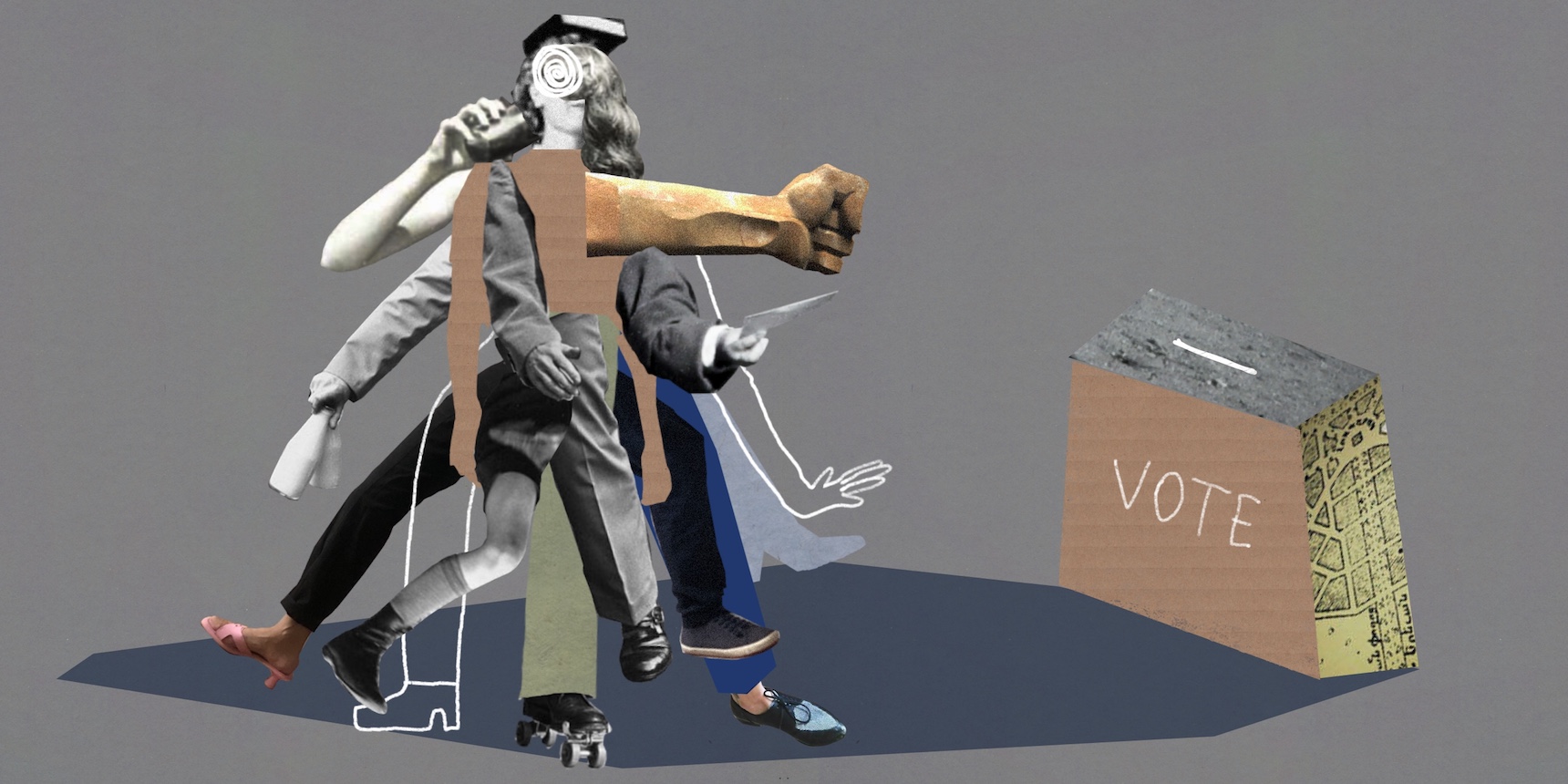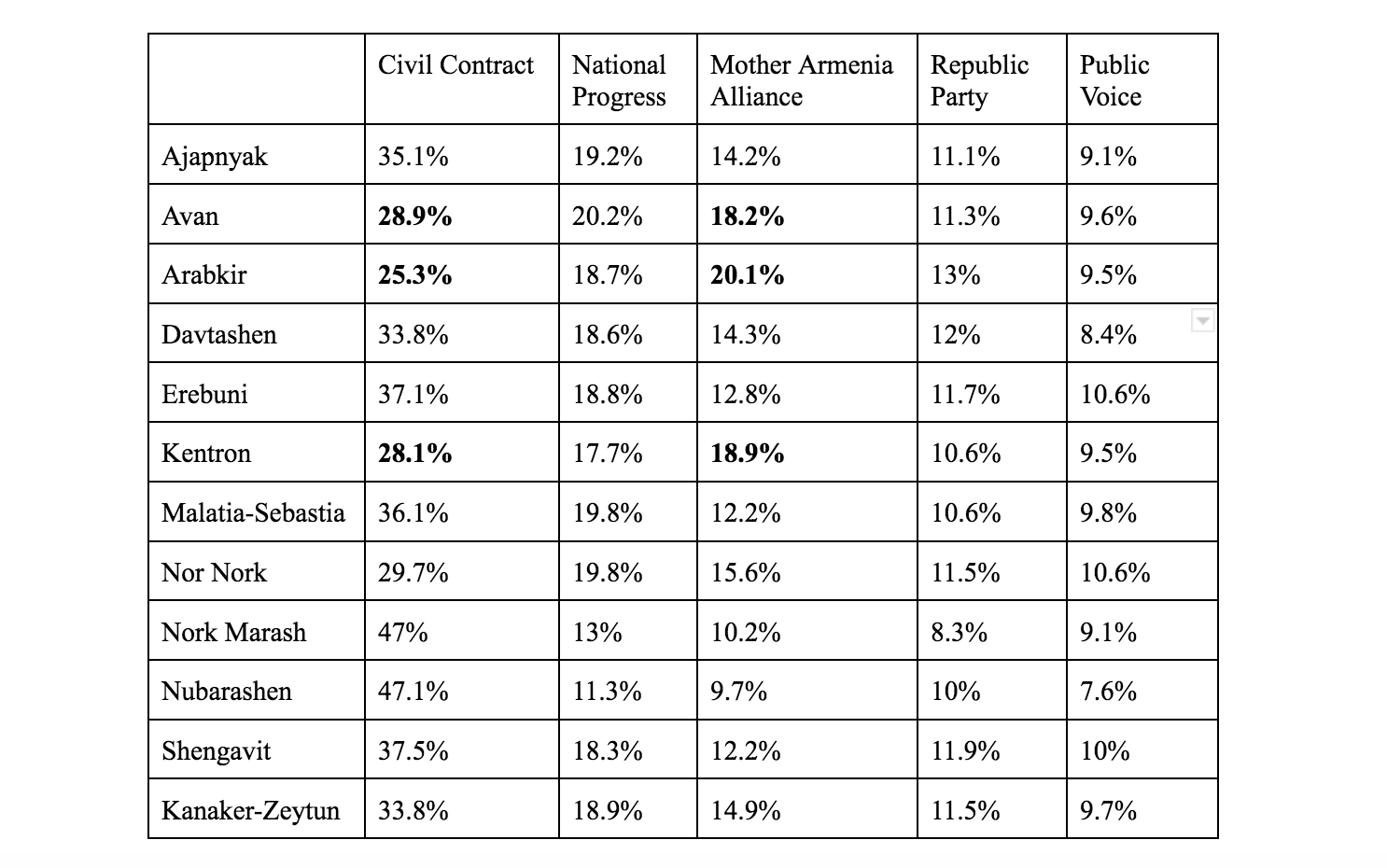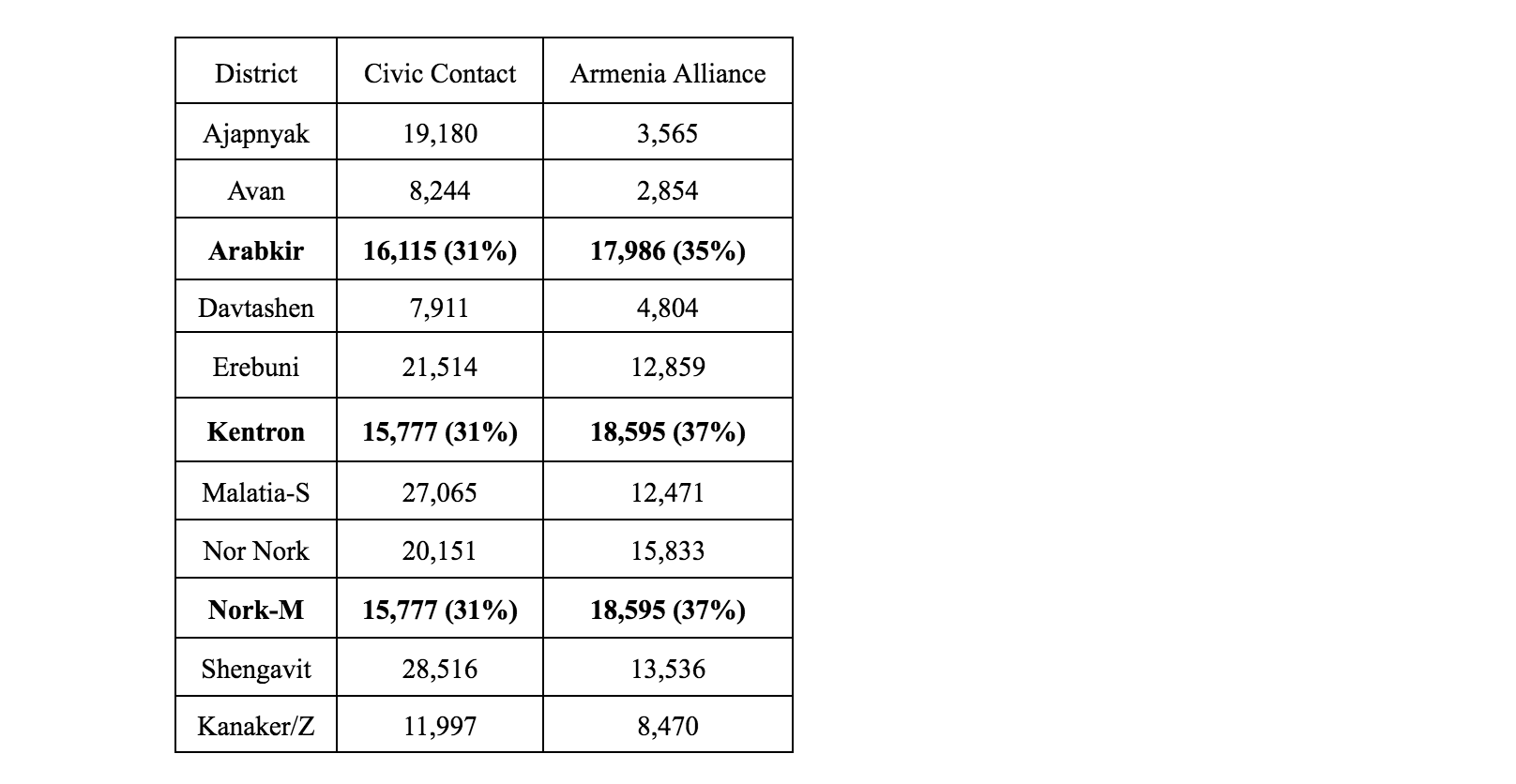
The 2023 Yerevan elections ushered in a new era of electoral politics in Armenia, as the pro-democracy parties diversified and reshaped the electoral landscape, while the remnants of the country’s illiberal parties plunged into electoral irrelevance. With two of the top performing parties having roots in the democratic values of the Velvet Revolution, Armenia witnessed the birth of political pluralism. Of the five parties that met the threshold, three are post-Velvet democratic forces (Civil Contract, National Progress Party and Republic Party), while one remains aligned with the pre-Velvet illiberal forces (Mother Armenia Alliance), and the other a neutral collection of pre- and post-Velvet figures (Public Voice Party). This development is a crucial departure from the narrative that has shaped Armenia’s political culture for the last five years: the polarization between the pre-Velvet and post-Velvet political forces. In essence, this election reduced the anti-Velvet forces into electoral irrelevance, as the post-Velvet factions developed a new course of politics in Armenia.
To this end, Armenia’s political discourse is no longer about non-democratic forces against democratic forces, or the authoritarian vestiges against Velvet values, but rather, a new political landscape has developed: the competing visions between Armenia’s pro-democracy factions. Substantively, and at the same time, Yerevan has become the most pluralistic political environment in Eurasia, with five political parties entering the Council of Elders, and no single party having majority dominance: a new, and more equal, distribution of electoral power has entered Armenian politics. Contextually, this not only represents the growing political sophistication of Armenian society when it comes to electoral preferences, but it also allows for a more nuanced understanding of Armenia’s democratic trajectory and depolarization. To this end, while the elections displayed a robust growth in pluralism, it also introduced the concerns of low turnout and the specter that is haunting most democratic systems: voter apathy.
Electoral Diversification and Pluralism
While Civil Contract dominated the electoral field, it failed to come anywhere close to the 50% majority required to assume control of the Council of Elders, a clear indication that Armenia’s political environment has undergone a diversifying shift. At the same time, the successful performance of the other two pro-Velvet parties demonstrated the growing pluralism that is shaping Armenian electoral behavior: Yerevan’s politics will be defined by coalition-building, not one party majority dominance.The distribution of the vote for the top five parties or alliances that met the electoral threshold are as follows:
- Civil Contract – 32.57% (seat allocation 24 out of 65)
- National Progress Party – 18.89% (seat allocation of 14 out of 65)
- Mother Armenia Alliance – 15.43% (seat allocation of 12 out of 65)
- Republic Party – 11.32% (seat allocation of 8 out of 65)
- Public Voice Party – 9.68% (seat allocation of 7 out of 65)
With 65 seats in the Council of Elders, a coalition of 33 seats is required for a majority. With the top five parties absorbing 88% of the vote, the remaining 12% were absorbed by parties that did not meet the electoral threshold. The distribution of this residual 12%, in proportion to the vote size of each of the five parties, will determine the final seat allocation within the Council of Elders. The most probable coalition is between Civil Contract and the Republic Party, collectively holding 32 seats, thus missing one seat to form a coalition. Pending on the final distribution of the residual percentiles, if this coalition gets another seat, a majority will be formed and a mayor elected. If not, there will be another snap election. The probability of the remaining three parties forming a coalition remains exceedingly low: National Progress Party (NPP), Mother Armenia Alliance, and Public Voice Party have diametrically diverging political views and positions, and more importantly, neither NPP nor Public Voice Party would form a coalition with a faction that represents the anti-Velvet alliance within the electoral field.
The comparative considerations are quite instrumental in being able to gauge Armenia’s transition from single-party electoral dominance after the Velvet Revolution and the developing pluralism observed in this election. For analytical purposes, the 2018 mayoral elections and the 2021 Parliamentary election results in Yerevan will be compared with the results from the 2023 mayoral elections. While there are clear contextual differences between mayoral and parliamentary elections, and controlling for concerns of ecological fallacy, the 2021 elections will primarily be utilized to observe the performance trends of the Civil Contract party within Yerevan.
The findings indicate three important developments: a) Civil Contract has a robust electoral base of 33%, with the role of undecided voters shifting based on the presence or absence of pre-Velvet, nondemocratic parties; 2) the distribution within the pro-Velvet camp, comprised of three different parties in this election, remains commensurate with the performance of the single pro-Velvet camp in previous elections; and 3) the splintering of the vote distribution between the pro-Velvet camps, and the relative diminishing of the vote accrued by the anti-Velvet camp, reinforces the decline in polarization within Armenia’s political system, while at the same time enhancing political pluralism.
When disaggregating the electoral data in Yerevan by administrative districts, important observable trends shed light on the developing electoral climate that shaped the 2023 elections.

As has been consistent with Civil Contract’s core base, the disaggregated data demonstrates how the party performs its best in the middle and lower-middle class districts of Yerevan, as their dominant numbers indicate in Nubarashen, Nork Marash, Shengavit, Erebuni, Malatia-Sebastia and Ajapnyak. Similarly, there’s a negative correlation with Civil Contracts performance in the more affluent districts of Yerevan, such as Arabkir and Kentron. The performance of the Mother Armenia Alliance, qualified as a proxy for former-President Robert Kocharyan’s Armenia Alliance, indicates relative strength in the affluent areas of Arabkir and Kentron, while performing quite weakly in the middle and lower-middle class districts.
This is commensurate with the electoral data from the 2021 Parliamentary elections, disaggregated by the Yerevan districts.

Civil Contract performed its worst in Arabkir and Kentron, the districts in Yerevan that it lost to the Armenia Alliance, while performing exceedingly well in the less affluent districts. Schematically, the further the electoral map departs from the center of the city and expands to the outskirts, the electoral base of Civil Contract becomes stronger. This trend has held in Yerevan both in parliamentary and mayoral elections. Even when observing the 2018 mayoral elections, which was a complete landslide for the My Step Alliance led by Civil Contract, it still performed its worst in Kentron and Arabkir (76% and 75%, respectively), when compared to the average of 82% throughout the rest of the city.
The performance of the National Progress Party, led by former mayor Hayk Marutyan, on the other hand, is quite unique: the party performed consistently well throughout the country, with the exception of Nubarashen, a Civil Contract stronghold. Both in affluent and blue-collar districts, NPP’s performance was remarkably consistent, absorbing the pro-Velvet voter block that has soured with the Pashinyan Government, while also handedly outperforming the illiberal Mother Armenia Alliance. With the exception of Kentron and Arabkir, NPP dominated the Mother Armenia Alliance in all of the remaining districts. Contextually, the splintering of the traditional pro-Velvet vote into two camps did not provide any benefits to the anti-Velvet faction, but rather, strengthened the diversification of the pro-democracy field. This is further reaffirmed by the performance of the Republic Party, a strong pro-Velvet party. When observing the collective performance of the pro-Velvet factions, as a unitary voter output, their numbers resemble the consistent performance of the pro-Velvet faction since 2018 (the electoral output exceeds the 60 percentile). The fragmentation of this vote into three different parties, at the same time, clearly demonstrates the diversification of voter preference, considering the distribution of the vote, as opposed to its singular concentration into Civil Contract. To this end, the political climate in Armenia has undergone an important seismic shift, for the competition for political office is no longer between pro- and anti-democracy forces, nor is it a battle between the entrenched powers of the authoritarian vestiges and the revolutionary zeal of the new political elite. A process of institutionalization is taking place, where the party that dominated the electoral field due to the euphoria of the Velvet Revolution is now cohabiting a diverse political landscape composed of its former allies, friends and competitors.
Low Voter Turnout and the Problem of Apathy
In the 2018 Yerevan mayoral elections, turnout was at 43.66%; in the 2018 parliamentary elections, the disaggregated turnout in Yerevan was 47.9%; and in the 2021 parliamentary elections, the turnout in Yerevan was 51.8%. That the 2023 Yerevan elections had a turnout of 28.46% has astonished observers of Armenian politics: how can such a politically active society, with such a high penchant for active electoral behavior, display such electoral insouciance? There are several sets of explanations, from the larger scholarly literature on low electoral turnouts to the effect that transitional and consolidation periods have on collective voting behavior. Armenia’s situation is not unique, but the reasons for it may be. Indeed, a growing body of survey data is suggesting a creeping sense of apathy among some Armenian voters, yet this was mostly negated by the 2021 elections. Similarly, there’s a certain disconnect, a degree of spuriousness between Armenian voters displaying signs of apathy in survey data, yet turning out to vote during elections. Considering the fact that one local electoral cycle is not sufficient to qualify the apathy syndrome as the underlying explanatory variable, what other explanations are there?
Deep trend analysis of voter behavior in the last three elections provides three explanations. First, Armenian voter behavior, especially since the 2020 Artsakh War, has been more defined by the anti-authoritarian vote than by the pro-government vote. Contextually, when voters perceive a threat to the post-Velvet political order, they vote strategically to safeguard the Velvet. As the 2021 parliamentary elections demonstrated, the vast majority of the undecided voters not only turned out to vote, but voted for Civil Contract. And as much of the survey data confirmed, this was not so much a vote in favor of PM Pashinyan, but rather, it was a strategic vote against Robert Kocharyan and the anti-Velvet coalition. Second, without the perceived threat to the post-Velvet political order, voter mobilization relatively diminishes, as undecided voters are not incentivized to turnout. Considering the fact that the two dominant parties were pro-Velvet, and noting the electoral weakness of the Mother Armenia Alliance, the undecideds did not turn out to vote, since the anti-authoritarian syndrome was not triggered. And third, depolarization tends to subside both mobilization and strategic voting, in which case the approximately 35% of the Yerevan electorate that is undecided simply did not show up.
Conclusion
That Armenian politics is entering a new period of coalition-building, inter-party negotiations, and a new landscape of pluralism and diversification is profoundly welcoming to its democratic trajectory and consolidation. The period of one party being the darling of the electorate is over; but at the same time, the era of fearing the anti-Velvet forces as a threat to the electoral field is also over. Considering the fact that the three parties that ruled Armenia prior to the Velvet Revolution (Republican Party, Prosperous Armenia, and ARF Dashnaktsutyun) did not field a single candidate reaffirms the new political course. At the same time, nascent parties that had displayed promises of being strong democratic alternatives, such as Bright Armenia and Country to Live In, performed abysmally. With depolarization taking root, and pluralism becoming institutionalized, perhaps Armenia’s political culture and its political forces will elevate the game as well: issues and policies will dominate the political discourse, and not personalities or unrefined rhetoric.
Magazine Issue N32
The City
Yerevan, the capital of Armenia, where one third of the population lives today, has borne witness to sweeping social, political and economic changes for centuries. It is considered the pulse of the nation, where critical decisions on the future of the country are formulated, where promises are made and sometimes broken, a city that has hosted immigrants, emigres and tourists, an urban center where gentrification and rapidfire development threaten its relationship with its residents, when a municipal election becomes more about national issues, instead of urban needs and requirements. This month’s magazine issue entitled “The City” features articles that delve into the nuances of municipal elections, present the political forces running for city council and the history and lost stories of an ancient capital.
Of Ownership and Citizenry
Ahead of municipal elections in Yerevan, Roubina Margossian writes that this fascinatingly adaptable city has hosted thousands of immigrants and a record breaking number of tourists this year, but its resources are running thin and the time before it can no longer catch up with its own development is fast running out.
Read moreIn Yerevan’s Mayoral Election, Coming In First Won’t Be Enough
While city councils are typically primarily concerned with issues like building permits, public transportation and garbage collection, several opposition candidates in the upcoming municipal election in Yerevan are channeling the post-war zeitgeist in which national security is the top issue.
Read moreYerevan, From Empire to “Union”
Ahead of municipal elections in Yerevan, Lilit Avagyan takes the reader on a journey of the capital city’s history, from foreign invasions to the fall of the First Armenian Republic to the Soviet era.
Read moreBy the same author
Abdication of Duty and the Art of Scapegoating
Russia is not simply abdicating its responsibilities towards Armenia; it is directly working against Armenia’s interests by aligning with Azerbaijan to strengthen the Russo-Azerbaijani axis and methodically discredit official Yerevan.
Read moreAutocratic Legalism and Azerbaijan’s Abuse of Territorial Integrity
Azerbaijan’s approach to the Nagorno-Karabakh issue is a perversion of the concept of territorial integrity. It makes a mockery of legalism and constitutionalism, hijacking the law and using it extra-legally to violate civil, civic and human rights.
Read more






